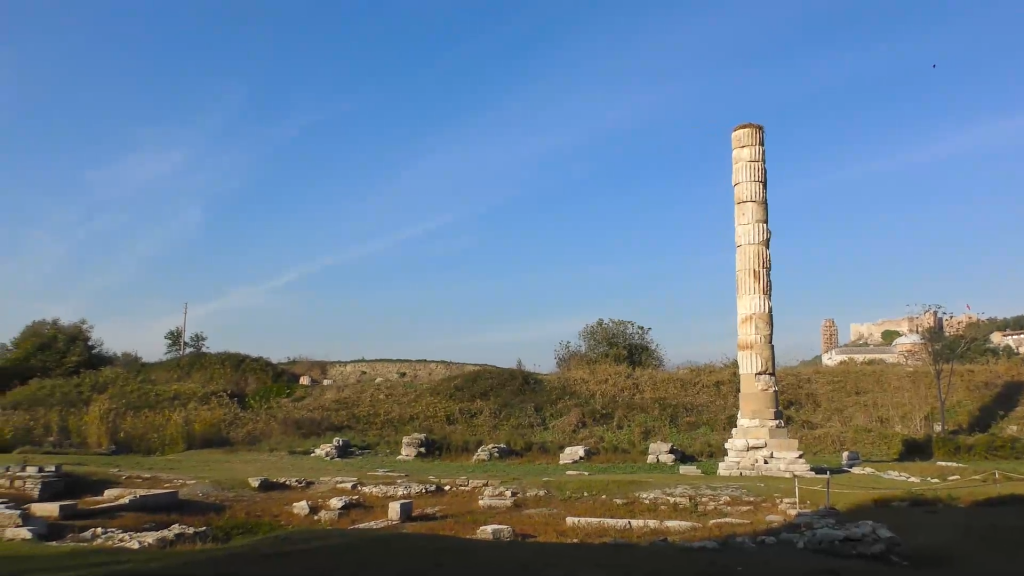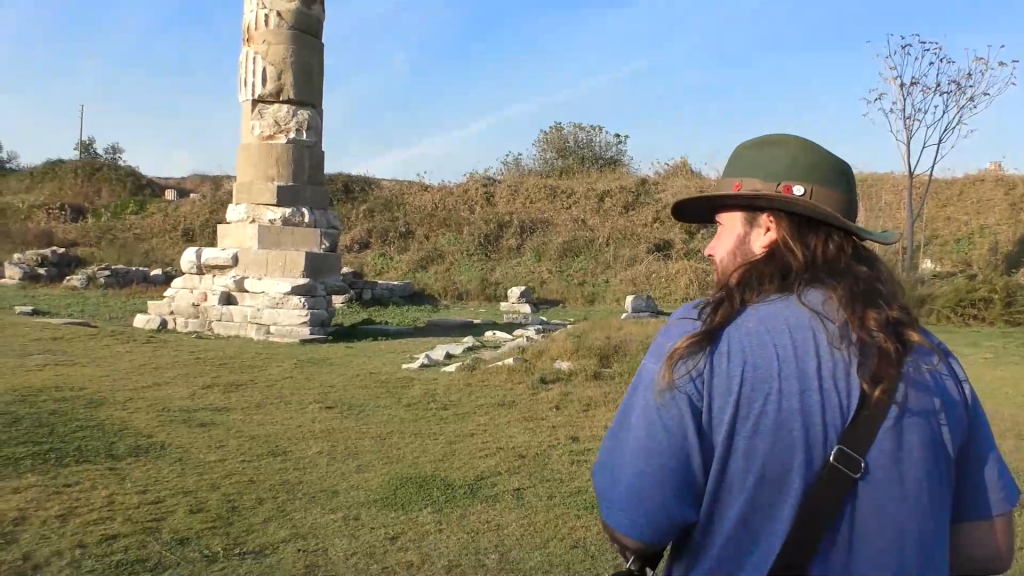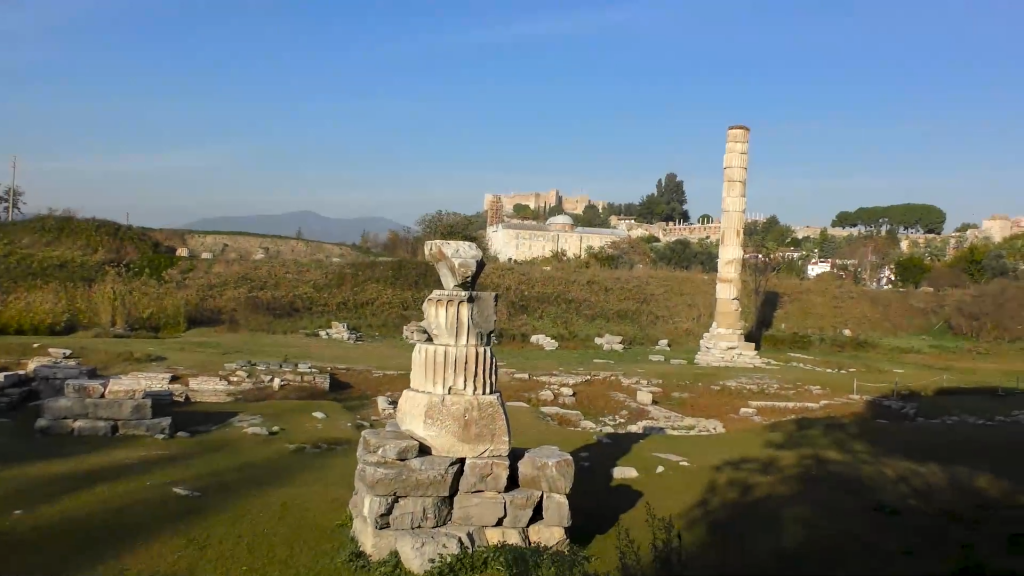The Temple Of Artemis & The Seven Wonders Of The World
A Blog Post By Greg

Over 2,000 years ago, in the year 225 B.C., Philo of Byzantium wrote a work entitled ‘On The Seven Wonders’, which was the first known list of the ‘Seven Wonders Of The World’. Of course, exactly what should be included on a list of the seven wonders is open to a lot of debate, and because of where and when it was written the list of ‘world’ wonders is focused on the Ancient Greek world and Egypt.
The seven wonders originally listed are:
- The Great Pyramid Of Giza
- The Hanging Gardens Of Babylon
- The Statue Of Zeus At Olympia
- The Mausoleum At Halicarnassus
- The Colossus Of Rhodes
- The Lighthouse Of Alexandria
- The Temple Of Artemis
Of these, the only one still actually standing intact is The Great Pyramid, the pyramid built for the Pharaoh Khufu. Considering that it was built in around 2,600 B.C, that also makes it the oldest of the wonders, which just goes to show that the Ancient Egyptians certainly knew how to build a pyramid!
The Hanging Gardens of Babylon, at the other end of the spectrum, may never have existed at all! It is not mentioned in any Babylonian texts which have survived, which leads some to believe that the gardens never existed, and were actually a mythical place that Roman and Greek writers wrote about to show an ideal of an eastern garden. It is also possible that the gardens existed but we have no contemporary records of them.
The rest of the wonders have all since been destroyed, but we do know where most of them were sited, and for some of them some of the remains are still available to be seen.
One of these sites is the subject of this post, the Temple of Artemis, which was built on a site near the Greek port city of Ephesus in the Izmir Province of Turkey, and which we had the opportunity to visit during the filming of ‘Turkey: Fairy Chimneys and Underground Cities‘.

We didn’t really know what to expect from the site before we went, although we had by that point in time visited a number of historic sites in Turkey, including the Ancient Greek and Roman Ruins of Hierapolis and Laodicea. At all of the sites we had visited so far we had been impressed with how well cared for the sites were, and the efforts which had gone into their preservation. We expected to see the same at the Temple of Artemis.
I’m going to pause at this point in the blog to say that we visited the site of the Temple of Artemis in November 2019 and that what we saw of the ruins then may have changed now. I also want to point out that in general this is a positive blog, and I try to write about places which I can speak positively about. In this case, however, we were disappointed by this site in comparison to all of the others we had seen.
As one of the ‘Seven Wonders’, we had high hopes for seeing the Temple of Artemis as we left the hotel. We were aware that the temple had been destroyed by Ostrogoths in the 3rd Century A.D., and that archaeologists hadn’t begun to uncover the ruined columns until the 1860s, and that there wasn’t much of the temple still remaining, and we were interested to see how what they had found would be presented.
The ruins which we were going to see weren’t actually the first ruins of the Temple of Artemis. Several temple structures dating back to the Bronze Age had been built on the site throughout its history. The structure which stood on the site leading into the 7th Century B.C. was destroyed by a flood, which meant that a rebuild was necessary.
In 550 B.C. work on a new temple began on the site, and the work took ten years for them to complete. It may have been the first of the Ancient Greek temples to be made in marble, and was dedicated to the goddess Artemis (known to the Romans as Diana), daughter of Zeus, God of Thunder, and Leto. Artemis is probably best known as the ‘Goddess of the Hunt’, although she was also the goddess of wild animals, the moon, the wilderness and chastity.
This version of the temple survived for a little under 200 years, until in 356 B.C. it burned to the ground.
A lot of people these days talk about ‘Reality TV Stars’ and other people who seem to just want to be ‘famous’, and it is clear that there are some people who seek fame at almost any cost. This isn’t, however, a new phenomenon, and it seems that it dated back at least as far as the second Temple of Artemis, and to a man named Herostratus.
According to some sources, Herostratus was a man of low social standing who wanted to be famous at any cost, and would risk the anger of one of the most widely worshipped goddesses in the Ancient Greek world, as he decided to burn down her major temple at Ephesus. This gives rise to the term ‘Herostratic Fame’, meaning fame sought at any cost, particularly referring to people who commit crimes in order to become famous. It didn’t really work for him as he was executed before he could know whether he became famous, and a law was passed making it illegal to write or say his name (a law which clearly some people chose to break as we know of him today).
You might be wondering how the worshippers of Artemis explained the fact that someone could burn down her temple without her stopping them. The answer is that the temple is said to have burned down on the 21st July 356 B.C., the day that Alexander the Great was born, and that Artemis was busy attending that birth and so was distracted while her temple burned down.
Finally, in the year 323 B.C. construction began on the final Temple of Artemis, and was the largest temple built on the site, standing 450ft by 225ft, and 60 ft high, with 127 columns, each approximately 4ft wide. So impressive was the temple that one description of the temple at the time compared it very favourably to some of the other wonders:
“I have set eyes on the wall of lofty Babylon on which is a road for chariots, and the statue of Zeus by the Alpheus, and the hanging gardens, and the Colossus of the Sun, and the huge labour of the high pyramids, and the vast tomb of Mausolus; but when I saw the house of Artemis that mounted to the clouds, those other marvels lost their brilliancy, and I said, ‘Lo, apart from Olympus, the Sun never looked on aught so grand.”
This temple stood longer than its immediate predecessor, surviving until the year 268 A.D. when a raid by an East Germanic tribe, the Goths, set fire to it as part of a campaign of raids upon various cities. We don’t know for sure how extensive the damage was, as then the history of the Temple of Artemis becomes a little murky as there is some suggestion in 5th Century works that the temple was finally closed due to the spread of Christianity leading to Pagan Temples being closed down or destroyed.
Either way, the temple was lost until an expedition sent by The British Museum in 1869 found the site, and began a series of excavations lasting five years, with some of the fragments of the most recent two temples still on display in the museum today, along with more found in excavations in 1904-1906.

As a result of the destruction, along with the fact that the late-19th and early 20th Century excavations removed a lot of what was left at the site and took it back to The British Museum in London to be preserved and displayed there, there really isn’t a lot left on the site of the Temple of Artemis. The photograph above basically shows what is left on the site (sat below St. John’s Basilica in the background). There is one roughly reconstructed column out of the original 127, and part of another, and then various stones and fragments scattered around the site.
There has clearly been some care shown to the site, because of the restoration of these columns. While we were visiting Laodicea on the same trip to Turkey we had seen two of the team there starting the process of restoring one of the columns there, and the amount of time and effort which it was taking just to get the first few pieces into place.

The site itself, however, looked sad. It was clearly in a park used for walking dogs, and some of the owners had not cleaned up after their dogs. Around the outside were overgrown hedges, and a pool of green water amid the ruins filled with frogs which was nothing like the beautiful crystal clear pool which we had seen people swimming in while we were at the ruins of Hierapolis.

Standing on the site, I couldn’t help but think about the weight of history on the spot. How for over a thousand years people had worshipped in temples on this site, rebuilding them when they were destroyed by floods or fire. People would have travelled just to see the site, and ancient writers thought it an important and impressive enough site to include it in their writings about the ‘Seven Wonders of the World’. More recently, the time had been taken to restore what they could of the columns remaining on the site, and this echoed through history back to each of the successive groups of people who had tried to rebuild the temple each time it was destroyed.
There is also something poignant, considering that it was the spread of Christianity, and the Christian persecution of Paganism, which had led to the final closure, abandonment and ruin of the Temple of Artemis that these ruins sit below the site and ruins of the Christian ‘Basilica of St John’, visible from the site of the Temple of Artemis, and much better restored, staffed, sign-posted, and generally cared for.
Overall, I am glad we visited the site of the temple, and if you visit the site then be sure to also visit the nearby Ephesus Museum, where some of the relics and statues from the site can be seen, as well as a model showing what the final temple would have looked like.
I hope that in the future it will be possible to improve the site, and present what remains at the Temple of Artemis in a way more fitting of its status in history!
Thank you for reading, and please take unbelievably good care of yourselves, and of each other!
Greg
P.S.
If you enjoyed this blog post, please leave a comment and say ‘hello’!
For information on all of our projects, visit: www.gregandfelicityadventures.com
Follow us on Instagram at: https://www.instagram.com/gregandfelicity
Like us on Facebook at: https://www.facebook.com/GregandFelicityAdventures
There are various places you can watch our documentaries and series!
Seeking Cetaceans In Scotland: A two-part documentary about the work of the Cetacean Research and Rescue Unit as they work to help whales, dolphins and porpoises in the Moray Firth in Scotland:
Free in the USA on Tubi TV at:
https://tubitv.com/movies/678018/seeking-cetaceans-in-scotland
Free Worldwide on PlexTV at:
https://watch.plex.tv/movie/seeking-cetaceans-in-scotland
With a library card on the Hoopla service where applicable:
https://www.hoopladigital.com/title/15313766
Free in the USA on Xumo at:
https://www.xumo.tv/channel/99991731/free-documentaries?v=XM00ILOFXCKLUC&p=74071
Buy it without ads Amazon’s Prime Video at:
UK: https://www.amazon.co.uk/dp/B09RVWVFCV
USA: https://www.amazon.com/dp/B09RVWJGY1
(Greg and Felicity are donating half of our streaming income on this documentary to support the CRRU).
Available to buy on DVD (with £5 from each donated to the charity): https://ko-fi.com/s/73e469d114
ROMANIA: SEEKING DRACULA’S CASTLE: Our travel documentary looking into the history, legend and castles connected to Vlad Dracula III, sometimes known as Vlad the Impaler, and a journey around Romania:
Free Worldwide on Plex: https://watch.plex.tv/movie/romania-seeking-draculas-castle
Free (USA) on Tubi: https://tubitv.com/movies/579192/romania-seeking-dracula-s-castle
Prime Video (From £1.99, no Ads) (UK): https://www.amazon.co.uk//dp/B08RDPZP14
Prime Video (From $1.99, no Ads) (USA): https://www.amazon.com/dp/B08RDJR4F2
TURKEY: FAIRY CHIMNEYS AND UNDERGROUND CITIES: A travel documentary across Turkey, from the Fairy Chimneys and Underground Cities of Cappadocia to the ancient Greek ruins of Ephesus and Hierapolis:
Prime Video UK (From £2.49, no Ads): https://www.amazon.co.uk/Turkey-Fairy-Chimneys-Underground-Cities/dp/B09KKSZLRW
Prime Video USA (From $1.99, no Ads): https://www.amazon.com/Turkey-Fairy-Chimneys-Underground-Cities/dp/B09KK6VDJB
Free Worldwide on Plex: https://watch.plex.tv/movie/turkey-fairy-chimneys-and-underground-cities
Free (USA) on Tubi: https://tubitv.com/movies/579225/turkey-fairy-chimneys-and-underground-cities
Greg Chapman’s Magic Show: An eight-part series of magic and entertainment with Greg:
Free in the USA on Tubi at: https://tubitv.com/series/300008713/greg-chapman-s-magic-show
Free worldwide on Plex: https://watch.plex.tv/show/greg-chapmans-magic-show/season/1
Available to buy on DVD: https://ko-fi.com/s/7c1bc10a08
Mexico: Mayan Mystery and Marine Majesty: Filmed on our honeymoon in Mexico in 2019, our first travel documentary took us through the ancient sites of Teotihuacan, Uxmal, El Tajin, Palenque, Chichen Itza and Calakmul, and then on to see the whales of Magdalena Bay, whale sharks of La Paz, and more.
Watch free on YouTube: https://youtu.be/yfMpD868MHU
The Isle of Man: Railways, Castles and Seals: Our second travel documentary took us to the Isle of Man!
Watch free on YouTube: https://youtu.be/uCpUa6XEkbg